How To Create A Production Schedule
L
et's face it, shooting schedules can be super complicated. Who's available when? How do we shoot the most expensive elements? It's easy to forget that a production schedule is as much a psychological tool as it is a logistical one. Here's how to make a schedule for your shoot that will increase the productivity and positivity of your team.
- Read the shooting script
- Schedule people not scenes
- Schedule difficult scenes earlier
- Schedule easier scenes later
- Consider talent performances
- Don't abuse the crew
- Help the director start strong
- Schedule chronologically
- Make room for creative discovery
- Team-building tool
- Make day one a big win
- Set your film crew up for success
- Create a secret shooting schedule
- Avoid burnout
- Take the third day off
Read the shooting script
1. Read and understand the story
Sure, you can put together a production schedule from breakdown sheets and a few notes from the director, but if you do that, you'll miss a lot of the nuance that makes your schedule truly effective.
Before getting started, you must first read the shooting script at least once without taking any notes. Just experience it. You'll learn which scenes are more important and which are emotionally challenging. That's knowledge you'll use to craft a more effective production schedule.

How to Make a Shooting Schedule Tip: Read the Shooting Script
Schedule people, not scenes
2. Account for people's energy
Preparing the breakdown sheets can put your mind into a logistical frenzy: everything is an "element" that needs to be scheduled, coordinated, and accounted for. But unlike a breakdown sheet, your production schedule isn't for stuff. It's for people, and it needs to account for people's energy and creative processes. As you work through the production schedule, ask yourself the following three questions for each scene:
- Who's working hardest in this scene?
- Who needs a break after the last scene?
- Who hasn't been busy for a while?
Shape each day around the ebb and flow of your cast and crew's creative energy, and you'll have a smoother shoot. More importantly, you'll have a production schedule that inspires creativity—creativity that will feed right back into the film you're making.
Schedule difficult scenes earlier
3. Prioritize difficult scenes
Actors deliver better performances when the production schedule accounts for their process. This is especially true in emotionally challenging or physically exhausting scenes.
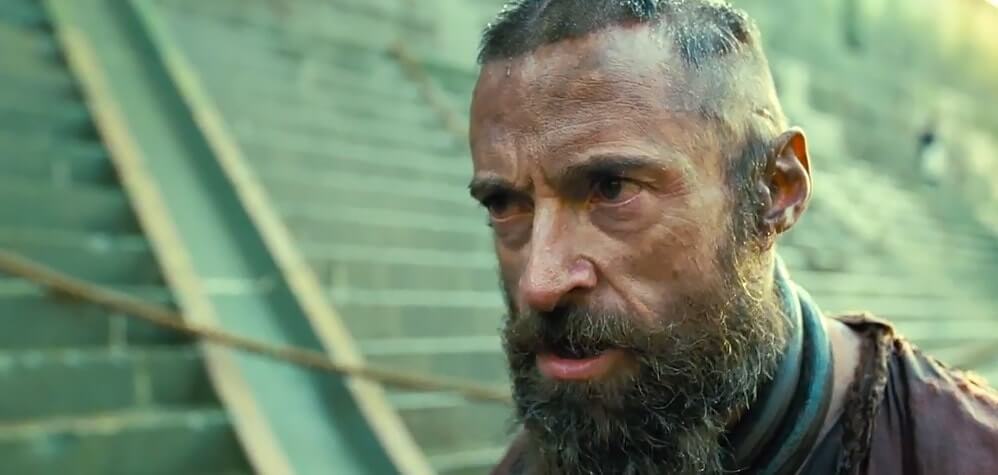
Haw to Create a Better Production Schedule Tip: Consider Actor Emotion
Actors can anticipate a difficult scene at the start of the next day and can prep for it the night before. If it takes extra time to shoot emotional scenes, you will still have the rest of the day to make up for lost time. Fortunately, if you read the shooting script prior to scheduling, you'll know exactly which scenes are the emotional turning points of the story.
Build Momentum
4. Schedule easier scenes later in the day
Have your cast and crew tackle difficult scenes up front and the easier scenes later in the day so they can breathe easier before going home.
In your production management software, you can automatically sync your script to your shooting schedule to strip out and organize scenes. Drag and drop each strip, arrange by day/night, location, or cast, and stay on top of the process.
Here's a sample shooting schedule. Be sure to click each scene header to get a preview of the script pages for that setup:
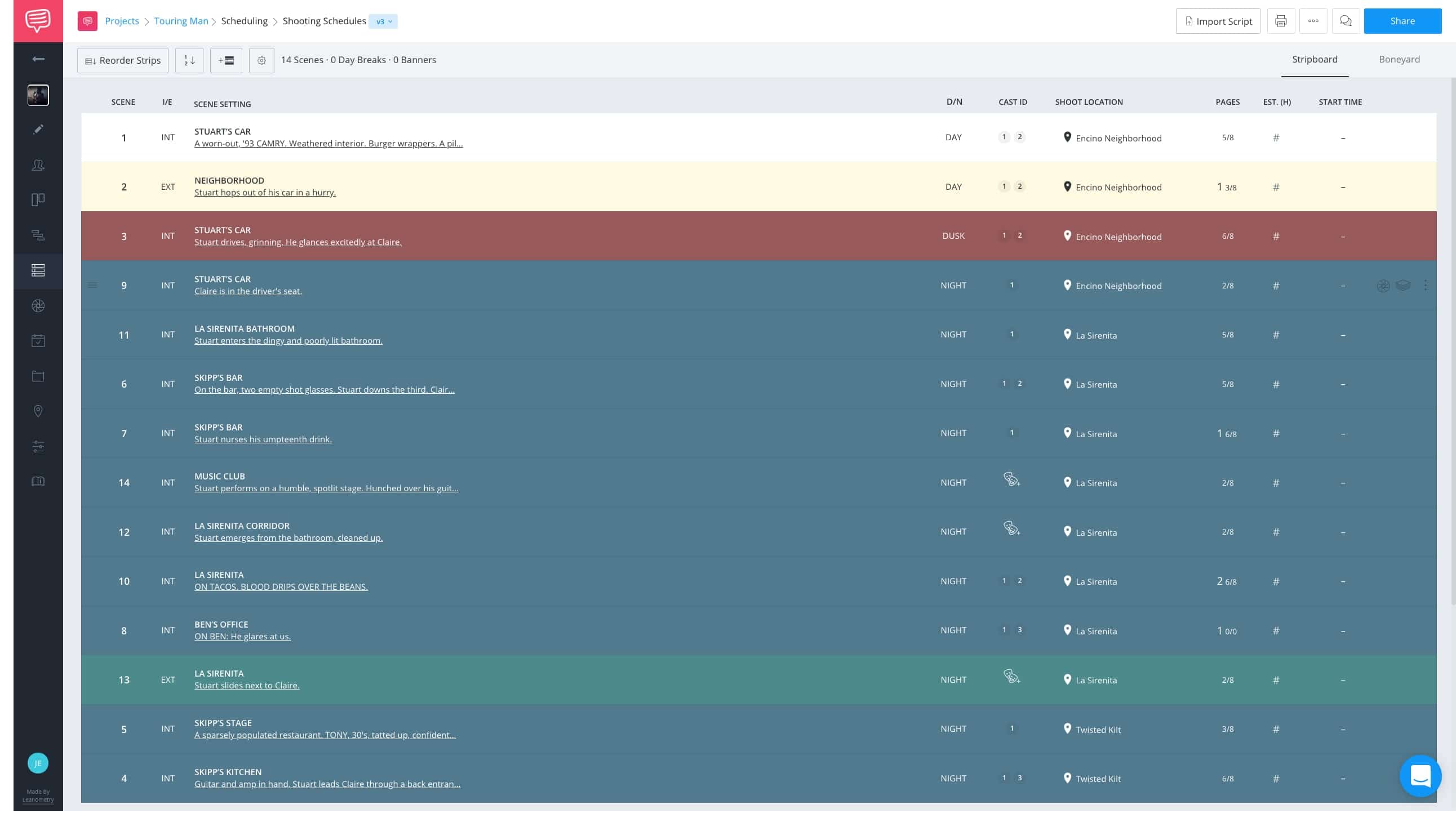
Shooting schedule software - the recipe for success.
If you schedule your shoot with your actors' well-being in mind, they'll come back happier the next morning — and every morning, for that matter.
Consider Talent Performances
5. Shifting emotional gears is a delicate process
If your cast has to shoot an emotional scene, don't schedule a very happy scene right after it (even if the happy scene isn't very complicated).
Shifting emotional gears is a delicate process.
Much like actors, the director also needs time to prepare for emotionally complex scenes.
This is another consideration you can plan for during your scheduling process. Check out this video to see the most efficient way to schedule your shoot:
An encouraging production schedule begins when you schedule your shots.
Write, revise, and create versions of your screenplay in-app, or import from another source, and automatically sync your script to create a schedule. From there, you can adjust and organize to suit your needs.
Reorder strips, add day breaks, and share with the team.
Don't abuse the crew
6. No drama on set
The same principles apply when it comes to the crew. If you're shooting a scene that calls for a 25-minute Steadicam shot, give your Steadicam operator a break when that scene's done.
Make sure you understand the time it takes for crew to accomplish their tasks (makeup artists often suffer here), and schedule accordingly. The last thing you need on set is drama after pushing people to a breaking point.
However, if you do find yourself in a tense situation, these pro tips on working with difficult people will help.
Help the director start strong
7. Work closely with the director
You should always work closely with the director when crafting a shooting schedule. After all, it's the director who's going to follow your schedule when the cameras roll.
Remember that the director's just as human as the rest of us, and needs time to put the crew through its motions and learn its quirks.
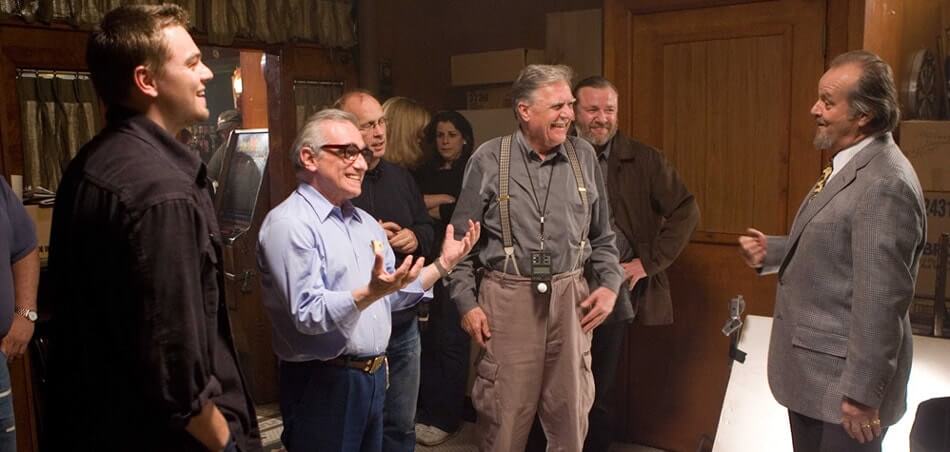
Haw to Make a Better Shooting Schedule Tip: Work with the Director
The first half of the first day of your shoot is the director's opportunity to establish the tone of production. Some directors are taskmasters on day one, so give them a technical scene with low emotional stakes—something that the crew needs to work hard to achieve, but that won't suffer from a little on-set tension. Other directors like to ease in and get everyone comfortable, so an easy day works better for them.
Maintain Story Flow
8. Schedule chronologically when possible
If you're shooting INT. LIVING ROOM – DAY, try to follow the script order in the shooting schedule.
There can be logistical benefits to this, but it also helps the director and actors maintain the flow of the story through the day.
creative discovery
9. Keep a creative insurance
There's an old Hollywood scheduling trick that you should know. Always shoot your first and third acts before you shoot the second act.
When your director and actors shoot the first and third acts of a film, they're establishing where the character and story begin and end. If they haven't shot the middle yet, they have room to discover nuances about their characters and story during production, and to make adjustments that will play consistently through the film.
For huge productions that take months to shoot, this is also a sort of creative insurance. If something bad happens to a central figure (such as a lead actor) during production, it's easier to write around that character in the 2nd act.
More wiggle room.
team Morale
10. Your stripboard is a team-building tool
A well-crafted shooting schedule can turn a crew into a team. It should build morale, momentum, and a positive work environment.
We've shared a sample stripboard above, in section 4.
Think of it as a team-building tool.
StudioBinder provides film scheduling software to help you plan out your scenes. No matter your solution of choice, make sure to brush up on how to create an effective shooting schedule.
Make day one a big win
11. Give 'em a win on the first day
Make sure your first shooting day is easy enough that production will wrap the day successfully. Give 'em a win, and they'll have momentum and optimism going into the rest of the shoot. However, don't make day one of production so easy that the cast and crew become complacent.
It's important to make them sweat a bit.
Set your film crew up for success
12. Nobody wants to go home frustrated
This rings true for day one as it does for the last day of production, and every day in between. Some assistant directors (ADs) and unit production managers (UPMs) like to over-schedule and assume they'll need pickup days at the end of the production schedule. But imagine you're on set every day, and no matter how hard you work, you hit the end of the day with scenes left un-shot. Everyone goes home frustrated.
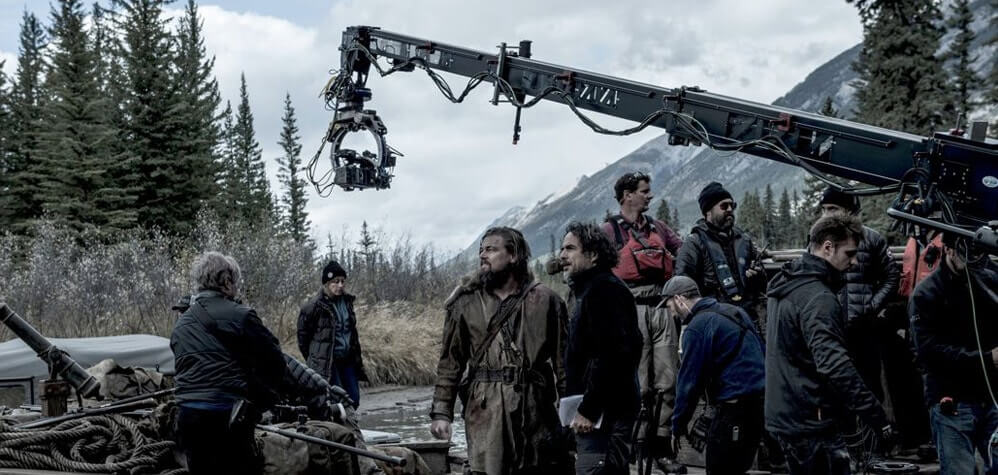
How to Make a Better Production Schedule Tip: Consider the Film Crew
It might have been the UPMs plan, but after enough of these days, nobody's really trying that hard anymore — why bother? By setting the bar at unrealistic heights, the schedule that has been laid out is "unpleasable," so what's the point in trying to do the impossible?
Instead, set up your cast and crew for success. Establish an encouraging shooting schedule. They'll thank you with harder work and better results. Which leads us to the next section ...
secret shooting schedule
13. Have a secret shooting schedule
Under-schedule your days just a little bit every day, but have a secret shooting schedule of scenes you plan to pickup when you're ahead of schedule. That way, the production they'll feel like they're crushing it and will want to continue their superlative streak.
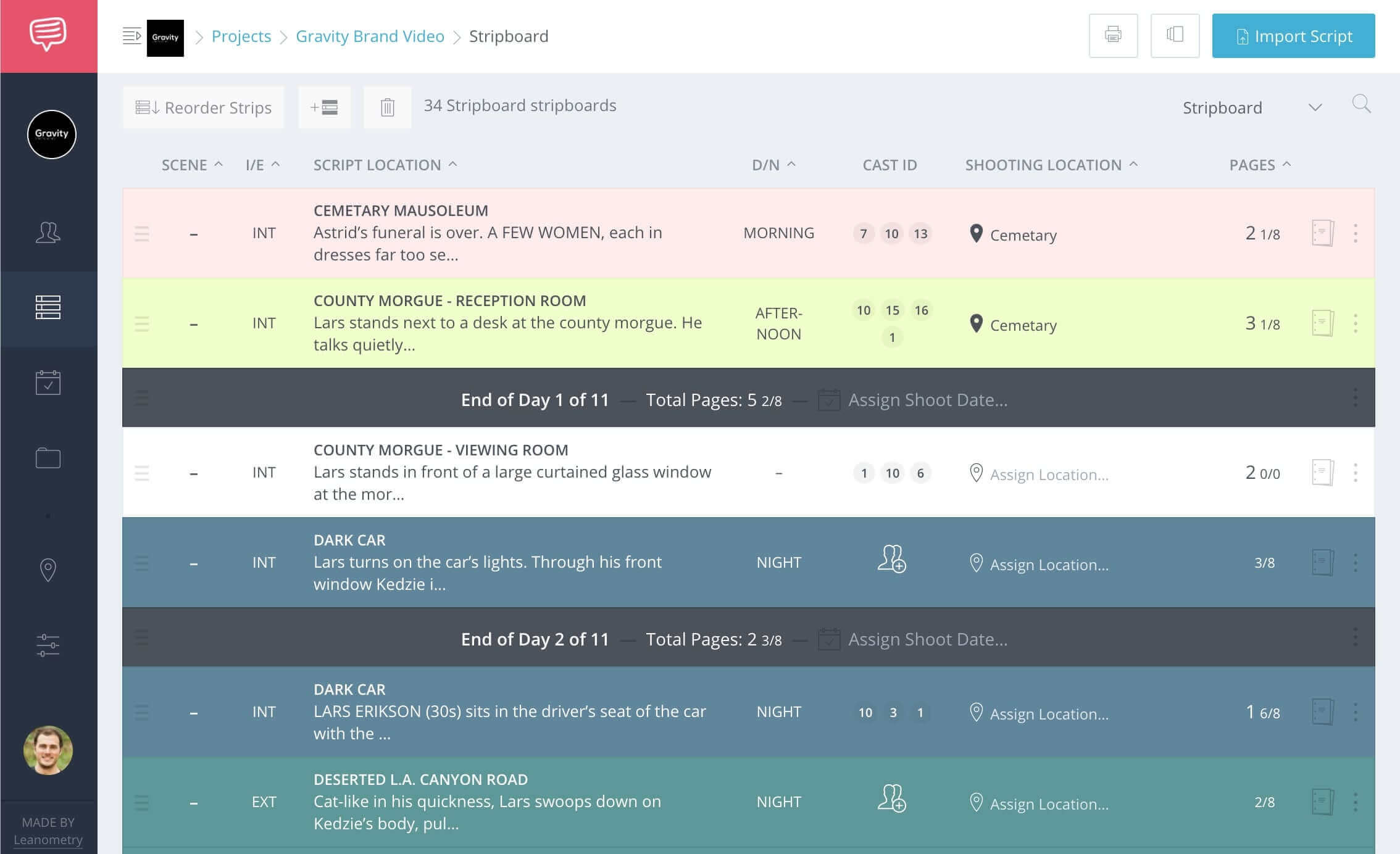
Shooting Schedule Techniques for a 10-Page Shoot Day - Add Banner Stripboard Schedule Template - StudioBinder
Share the secret shooting schedule with the director, AD and only key personnel.
As an additional resource, check out Checklist for Creating a Film Schedule or Script Breakdown and Film Scheduling.
Avoid burnout
14. Recharge with much-needed breaks
If your team reaches burnout, it's most likely your fault. Avoid 6-day and 7-day weeks whenever possible. Give people the breaks they need to recharge. You need their energy, not their time.
You can schedule breaks in your shooting schedule ahead of time, too.
Adapting Production Schedule
15. Take the third day off
It's tempting to assume our carefully prepped production schedule will go off without a hitch, but we all know perfection rarely strikes a film set. Because of that, the production schedule needs sufficient contingency for adjustments and alterations.
I learned this trick from a guy who got his start working for Orson Welles, and who spent years scheduling and running sets for Roger Corman at New World Pictures:
"Schedule your first day off after only two shoot days!"
This may sound crazy, but this third day off can be critical to a production. It's a chance to reconfigure or change crew, adjust the production schedule, tweak the shooting script, or make any of a million other possible changes.
Most importantly ...
It allows these changes to be made before too much time or money has been sunk into production. The team has had two days to test the waters, see how everything works, and identify problems. Why wait a whole week to fix them?
FREE Checklist Download
15 Shooting Schedule Pro Tips
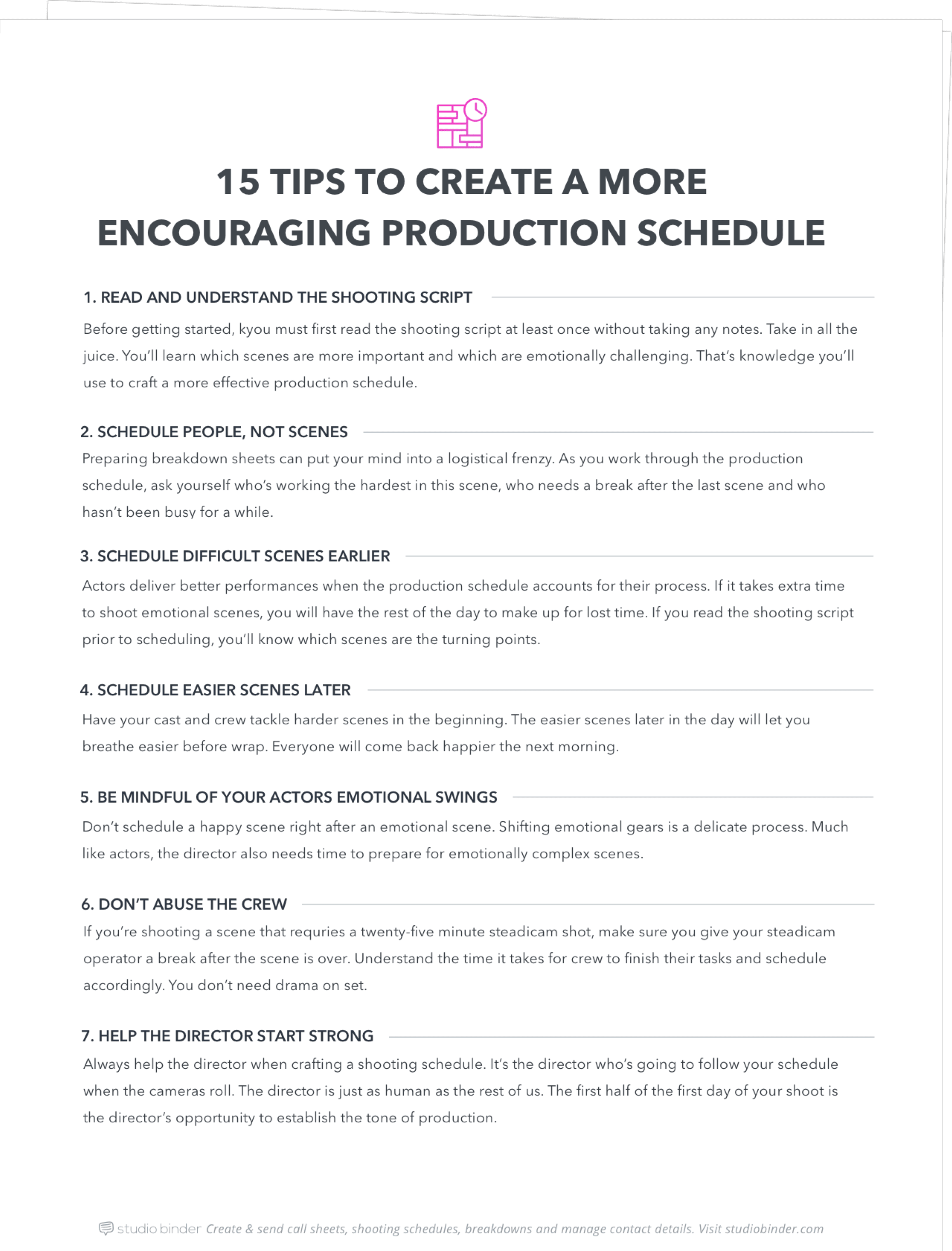
Download your FREE printable shooting schedule cheatsheet (PDF).
Just enter your email address and we'll instantly send it to you!
UP NEXT
How to Use a Stripboard to Make a Shooting Schedule
Your production schedule is a subtle, and very powerful filmmaking tool. At a minimum, if use your locations efficiently and shoot out your expensive talent, your production team will probably get the job done. However, if you incorporate individual creative and emotional needs, group psychology and management strategy into your schedule, your production will run smoother, and it may even impact the overall quality of your film.
If you enjoyed this post, check out the companion post on how to actually create a shooting schedule. And feel free to leave comments in the section below.
Up Next: How to Make a Shooting Schedule with a Stripboard →
How To Create A Production Schedule
Source: https://www.studiobinder.com/blog/15-pro-tips-to-create-a-better-production-schedule/
Posted by: robertsonbeirch1984.blogspot.com

0 Response to "How To Create A Production Schedule"
Post a Comment